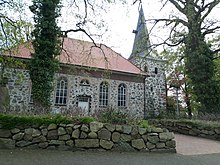St. Petri (Mulsum)
The Protestant St. Petri Church is a church building in Mulsum , a district of Kutenholz in the Stade district ( Lower Saxony ).
history
The first church in Mulsum, which was a small baptistery , was built in 786 by Willehad . Around 1100 Mulsum became an independent parish with its own pastor ; the former came from Harsefeld in earlier times .
Building history
Exactly when the current church was built is not known. What is certain is that it is the oldest church building in the area. The current nave dates from 1801.
The first church book was kept in 1667. In 1751 a new rectory was built, which today functions as a parish hall. In 1782 a new tower was built for 2000 Reichstaler after the old one collapsed. In 1801 the nave was renewed. From 1840 the Mulsum farmers refused to pay tithes , which were subsequently waived.
In 1866 an organ was ordered by Johann Hinrich Röver from Stade , which was installed in 1869/79.
In 1874 the new cemetery was inaugurated on the outskirts and the old cemetery at the church was closed.
In 1920 the tower clock was installed by the master watchmaker Wülpern. The striking bell came from 1741 and was cast by Johann Andreas Bieber from Hamburg .
In 1933/1934 the interior and especially the altar and pulpit were renovated. New and more comfortable seating and electrical lighting were purchased in 1962. Further renovation measures followed in 1995/96 and 1998–2001.
Furnishing
The altar with altar barriers shows the dying Jesus Christ . On it is the altar Bible from 1702 by Casper Holwein from Stade.
The pulpit bears figures of saints and is located above the altar. The church stalls , the hand-woven carpet in front of the altar and the baptismal font are from the 1930s and 1960s, respectively.
The organ was 1869/70 by Johann Hinrich Röver on the west gallery installed. It was renovated in 1989/1090 by Martin Haspelmath and returned to its original state. The disposition is as follows.
|
|
|
||||||||||||||||||||||||||||||||||||||||
- Coupling : II / I, I / P (II / P couples through)
In the tower there are four bronze bells from 1960 that replace the previous steel bells from 1925. One of the two is now in the belfry from 1985 at the parish hall in Kutenholz.
local community
In 1100 Mulsum became its own parish. In the 14th century, the residents of Ahlerstedt , Bevern and Hagen in Mulsum had to go to the church and had to cover distances of 25 km on foot.
Around 1500 the villages Mulsum , Etzell , Heßedorpe , Swynge , Groten Vredenbeck , Lütken Vredenbeck , Wedell , Aspe and Heymenkenbostel belonged to the parish. From 1795 the Hohenmoor settlement was also part of the parish, from 1822 Sadersdorf . In 1859, Hesedorf was repared to Bevern.
In the 1950s, Fredenbeck received its own church. Today the church Mulsum belongs to the Evangelical Lutheran parish of St. Peter Mulsum the church district Buxtehude in Sprengel Stade of the Evangelical Lutheran Church of Hanover with the villages Mulsum , Kutenholz , nettle , Aspe , Sadersdorf and swingarm .
Web links
- kirche-mulsum.de
- nomine.net Mulsum (near Buxtehude), St. Petri - organ by Johann Hinrich Röver (1869/71)
Individual evidence
- ↑ Organ on NOMINE e. V. , accessed on May 18, 2019.
Coordinates: 53 ° 30 '43.9 " N , 9 ° 18' 2.7" E

